Tank tanks of the Churchill ARK family (UK)
Hobart toy
The leading role in the creation of new engineering equipment was played by the 79-I Panzer Division under the command of General Percy Hobart. At that time, she created a number of techniques for various purposes, known under the playful nickname "Hobart's toys." In 1942, the specialists of the 79 division started designing a bridge-laying machine with a dropable bridge, and a new project appeared in 1943, which was more simple.
The new concept was quite simple. From the Churchill infantry tank, it was proposed to remove the tower and remove other "extra" equipment. On top of the body were two longitudinal three-section ladders. A tank with such equipment could in a minimum time turn into a gauge bridge, and its hull turned out to be the main support.
The use of the finished chassis of the Churchill tank ensured unification with other military equipment, facilitating production and operation. The carrying capacity of such a chassis was sufficient for the transportation of new equipment, and the strength allowed any existing armored vehicles to be launched over the bridge.
The project received the designation Armored Ramp Carrier - "Armored carrier ladder." Initially, this name was abbreviated to ARC, but later the changed name Churchill ARK appeared - literally "Ark".
Churchill ARK Mk I
The first version of the tank bridge was designed and built in the autumn of 1943. It implemented all the main proposals and determined the main features of the technical appearance. New modifications of the "Ark" to a large extent repeated the first option, designated as ARK Mk I.
On the chassis of the Churchill tank of the Mk II or Mk IV modification, sections of the gauge bridge should have been mounted. Its central elements were rigidly fixed on the fenders of the chassis and had a corresponding length. The front and rear sections of the smaller ladders were pivotally fixed.
No drive of swinging parts was foreseen. They freely moved in a vertical plane and could lay down on obstacles, providing entry and exit of other equipment. The organization of the bridge took the minimum time. In fact, the “Ark” needed only to approach an obstacle and take the required position, turning it into a bridge.
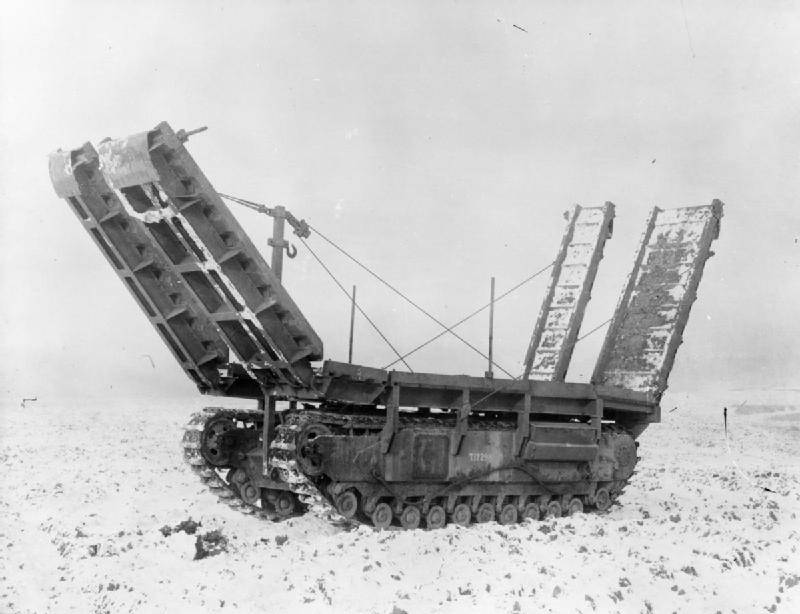
Tank-bridge Churchill ARK Mk II in transport position. All differences from the previous design are clearly visible.
The Churchill ARK Mk I tank bridge could organize crossings of various types of obstacles. Opening the ramps, he created a track bridge up to 10 m long and 3,3 m wide with sections of 2 feet wide (600 mm). The "Ark" provided the intersection of moats and scarpes, climbing obstacles, etc. On it, without any problems could drive any armored vehicles of the British army.
Tests of the experimental ARK Mk I were performed in the fall and winter of 1943-44. In February 1944, it was decided to launch mass production. The army ordered fifty tanks-bridges on the Churchill chassis of the Mk II and Mk IV versions. Basically, it was about the restructuring of existing infantry tanks. This technique was to participate in the landing in Normandy.
British and Italian pattern
After the start of fighting in France, in July 1944, the 79-I Panzer Division carried out a significant modernization of its tank bridge. With its help, it was planned to increase the basic characteristics and simplify the solution of tasks. This version of the machine was designated as ARK Mk II. Subsequently, the label UK pattern was added to the name, so as not to be confused with another similar modification.
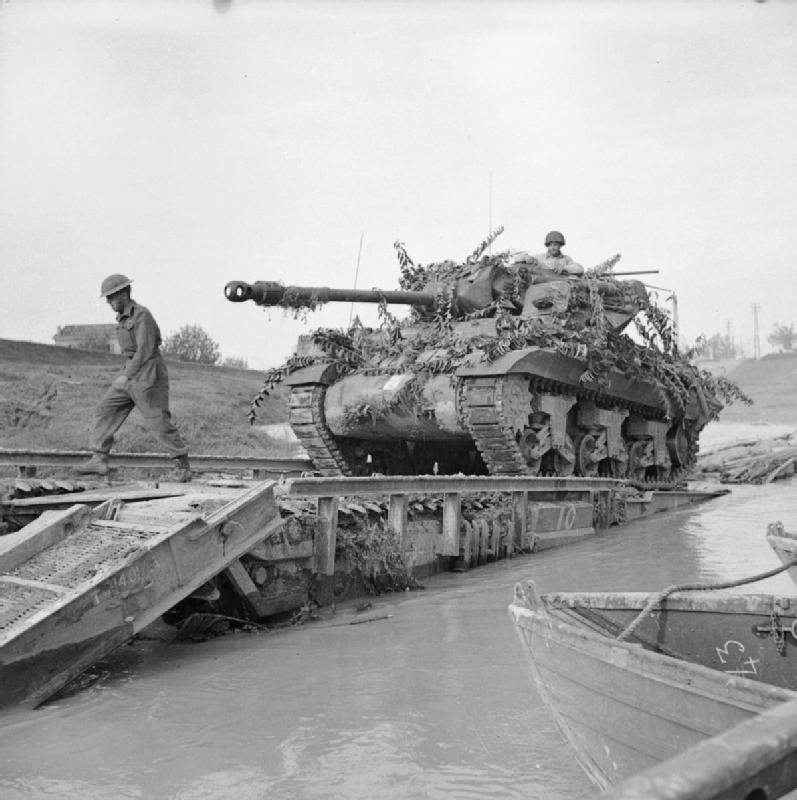
Crossing armored vehicles across the river. Savio (Italy), October 10 1944 The tank bridge of the "Italian model" is almost completely flooded
The tank bridge ARK Mk II was different construction sections. First of all, the length of the swinging ladders was increased. The left elements of the bridge were also changed - their width doubled, to 1,2 m. Thanks to this, not only various tanks, but also cars with a smaller gauge could ride the "Ark". The design of the fixed central sections has also changed, as a result of which their dismantling for access to the engine compartment has been simplified.
In the transport position, the elongated ladders were placed at an angle and held by a system of masts and cables. At the command of the crew, the locks on the cables were opened, and the ramps under their own weight fell to the ground. To leave the position, the help of other engineering equipment was required, which was able to raise the ladders to their original position.
At the testing stage, new moving ladders of different lengths were tested, which made it possible to overcome wide obstacles. The final version of the ARK Mk II received devices that allowed organizing a ferry 12-15 m long. In addition, there were additional mounted sections 3 m long for installation on standard ramps.
Churchill ARK Mk II UK pattern entered the supply of troops and replaced in the series produced Mk I. Maximum unification allowed the operation of two machines at the same time without any problems.
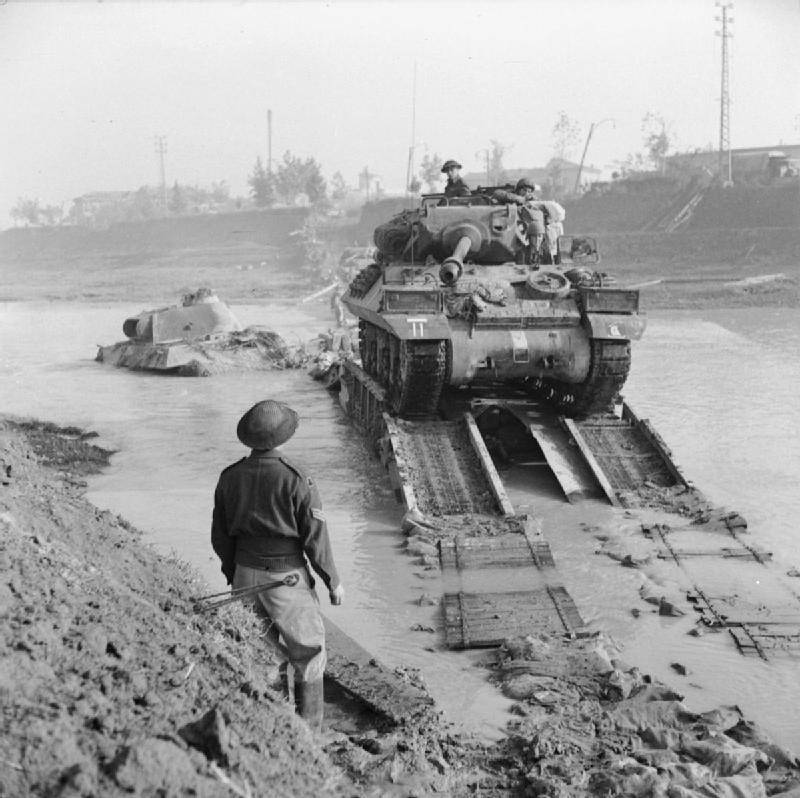
The same crossing, view from a different angle. In the background - a stuck enemy tank
In the same period, military engineers of the 8 Army operating in Italy proposed another version of the "Ark." This small-scale tank bridge was originally called Octopus, but later received the designation ARK Mk II Italian pattern. In the manufacture of such machines, American-made ladders of 4,65 or 3,7 m length were used. They were fixed on hinges to the body; a cable system was also used to hold it in a transport position. There were no central sections on the hull: the bridge’s flooring turned out to be the tank’s own tracks. Bridge tanks of the “Italian model” were made by military workshops by rebuilding Churchill Mk III tanks.
Experimental samples
During 1944, several new designs were proposed on the basis of the existing Churchill ARK with various features. Unlike the bridge tanks Mk I and Mk II of two versions, they did not reach serial production.
The first was the Lakeman ARK tank bridge. This project involved the use of a base tank in its original configuration. A gauge bridge was installed on it with the help of high trusses and hung over a standard tower. With the help of such a machine, another technique could overcome higher obstacles. In addition, the Lakeman ARK retained some of the combat capabilities of the tank. However, such a sample was considered unnecessary, and he did not advance beyond the tests.
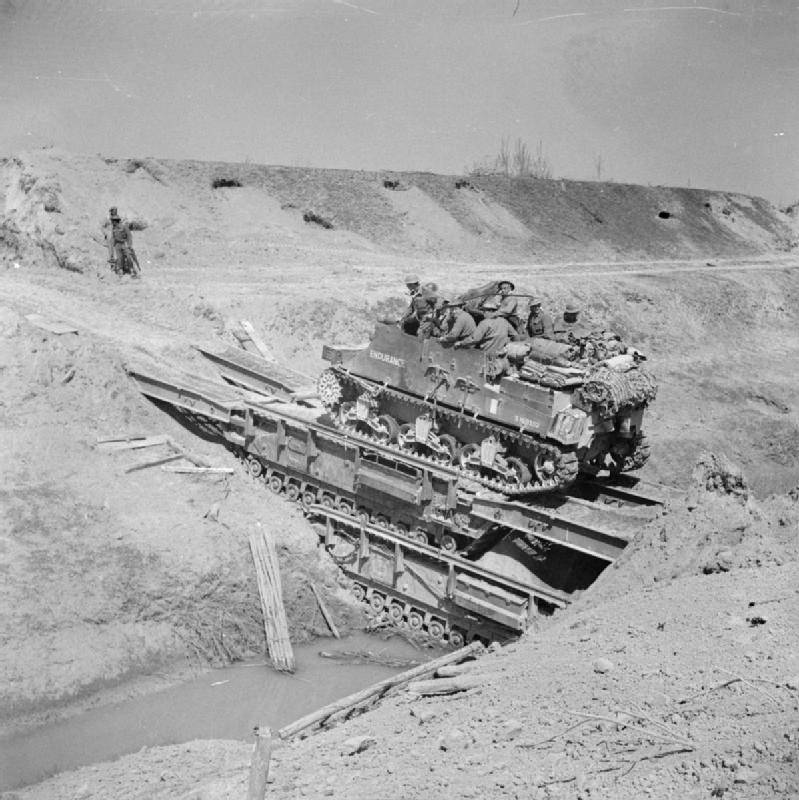
Two Mk II Italian patterns formed a bridge over a ravine and a river. Italy, April 10 1945
The Great Eastern Ramp project included the installation on the tank of a more complex three-section bridge, located with a slope back. The front section of such a bridge was supposed to lie on the central one and drive forward with solid-fuel rockets. The tests of the experimental tank-bridge were successful, and an order appeared for the 10 pre-production vehicles for military tests. However, the war in Europe was coming to an end, and soon this order was canceled as unnecessary.
"Ark" in operation
The tank bridge based on Churchill was created specifically for future landings in continental Europe. Accordingly, the first cases of the use of such equipment on the battlefield date back to 6 on June 1944. The action of the British units on the Normandy coast was provided by the ARK Mk I tank tanks. The equipment of the following modifications appeared later, after the start of the fighting.
"Arks" made in Great Britain were used mainly on the "second front". The grouping of troops operating in Italy did not receive such equipment, but built it on its own from existing tanks. Thus, the necessary tank tanks were available on all sectors of the front and were actively used.
The predominantly offensive nature of the operations of the Allied armies in Western Europe contributed to the frequent use of engineering equipment. Churchill ARK of all modifications were regularly used to transport combat vehicles through ditches, escarpments, ponds and other obstacles. Over time, new methods of using tank tanks were mastered. So, deep trenches or ravines could be crossed with the help of two "Arks"; while one stood on the roof of the other. The use of several machines made it possible to create bridges of increased length.
In total, several dozen Churchill ARK bridge tanks of three versions were built and sent to the front. A few more options for this technique did not go beyond the landfill. Until the end of the fighting in Europe, production vehicles provided overcoming obstacles and made an important contribution to the fight against the enemy.
After the war, the surviving "Arks" remained in operation for a long time. At the same time, new methods of their application were worked out. So, the Twin-ARK project proposed the use of two tanks at once with reinforced and elongated ramps. They should have been placed side by side, which made it possible to organize a longer and wider crossing capable of withstanding tanks of new models.
However, Churchill ARKs remained in service for not too long. The basic Churchilli were removed from service and replaced with new tanks, which lost one of the main advantages of the Ark. In the fifties, tank tanks of this family were removed from supply and gave way to new models of engineering equipment with similar tasks, but with different equipment. Bridge tanks were considered unpromising and replaced with full-blown pavers with a dropable bridge.
- Ryabov Kirill
- Imperial War Museum / iwm.org, Chamberlain P., Eliis C. "British and american tanks of World War II"
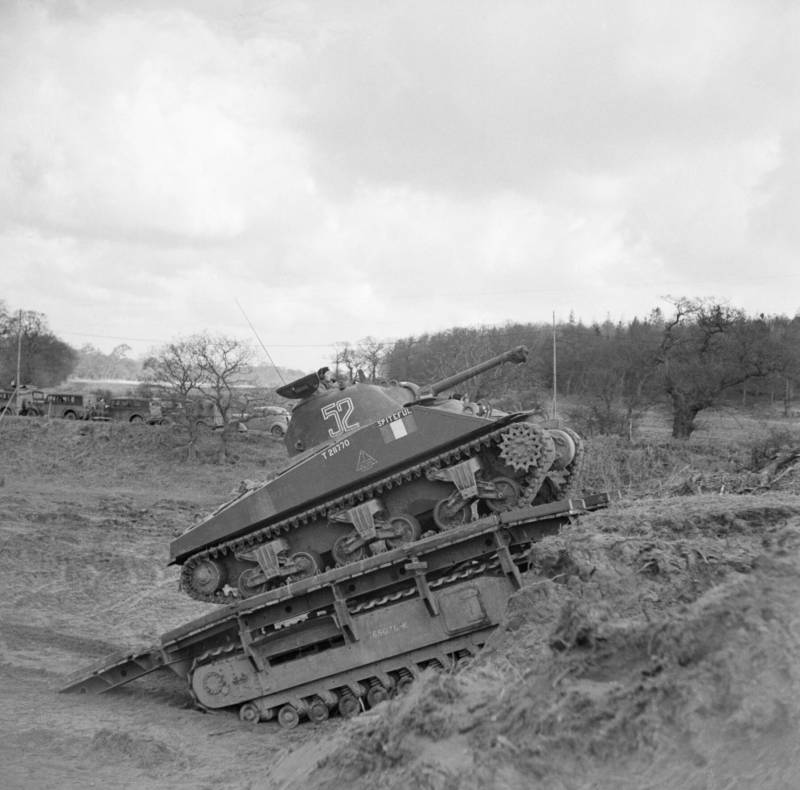
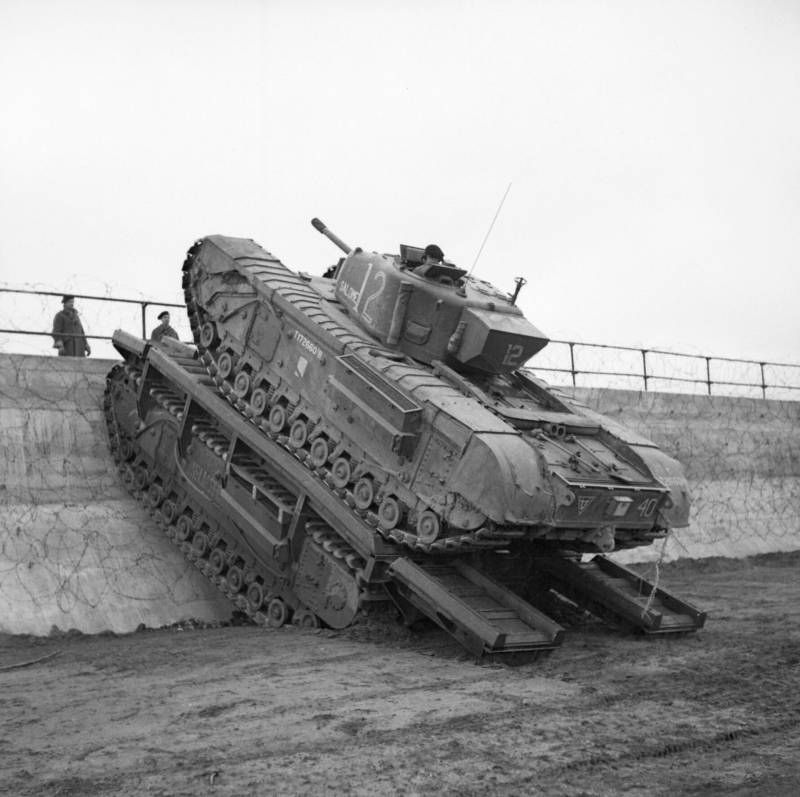
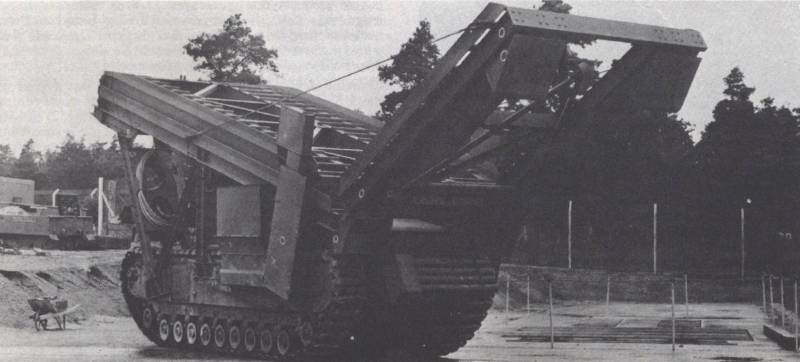
Information